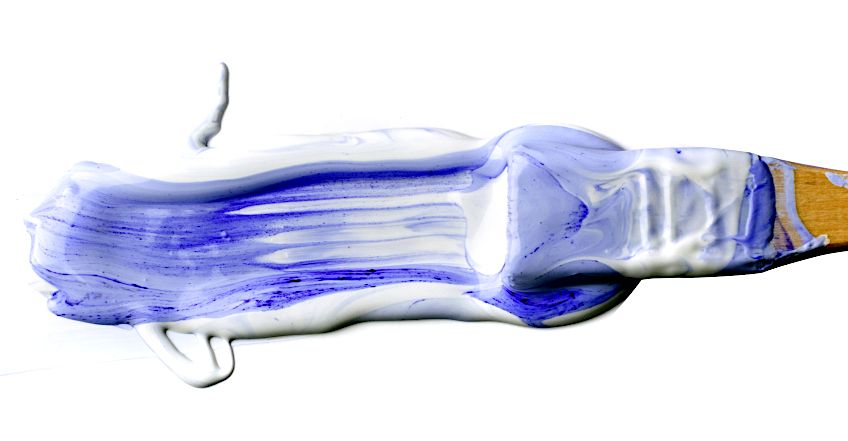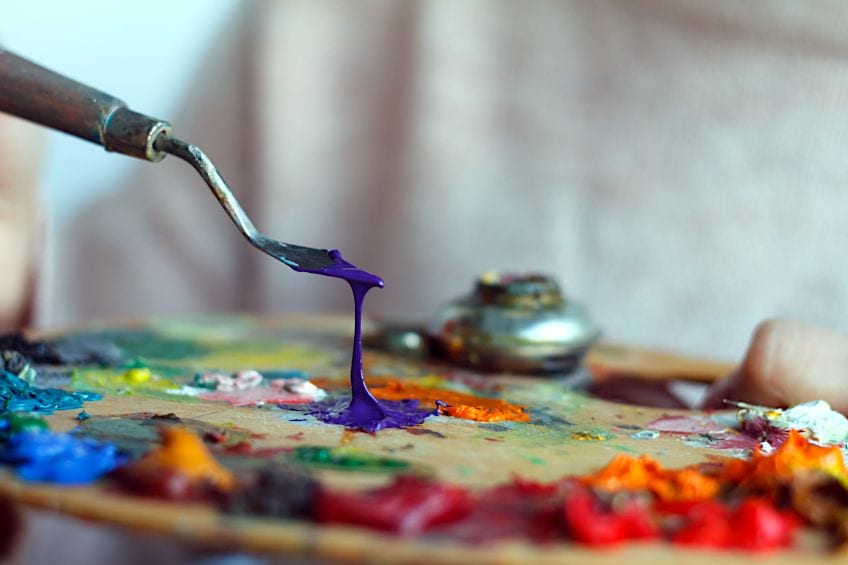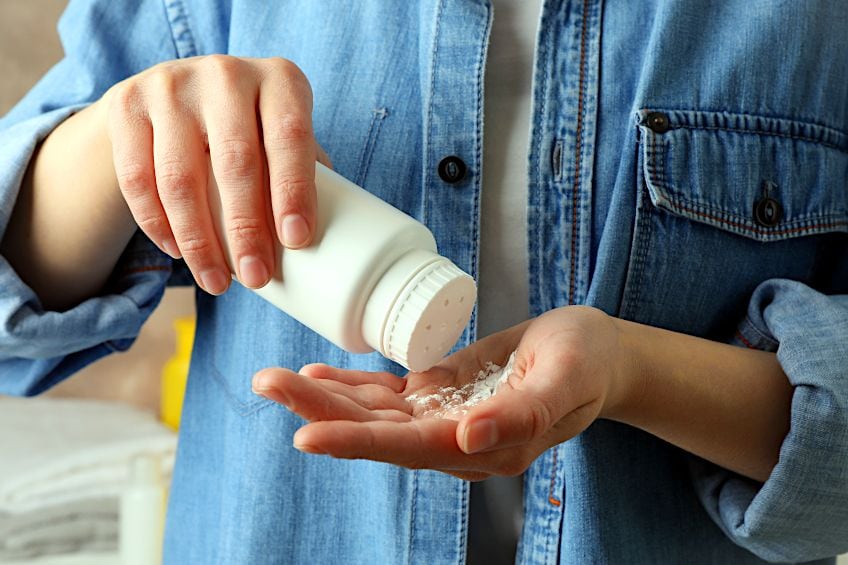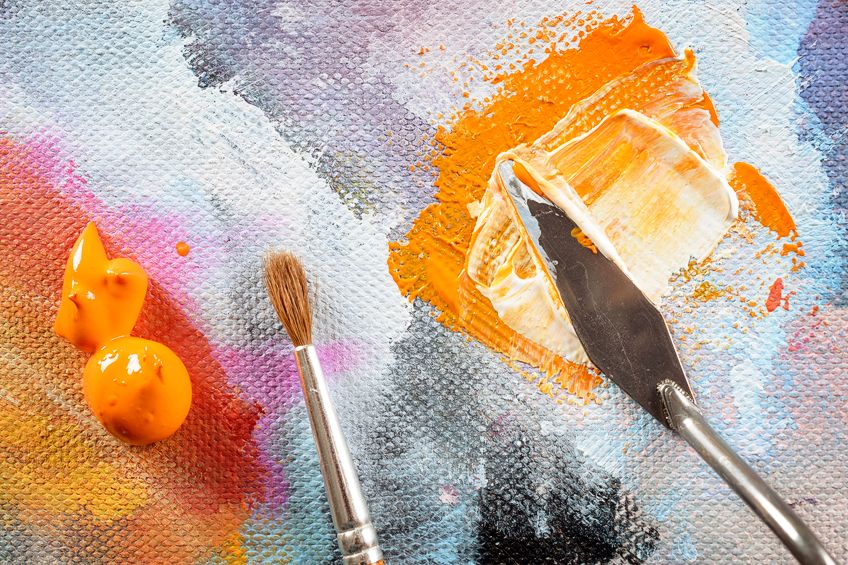How to Thicken Acrylic Paint – Using Acrylic Paint Thickener
The art of painting is one of the most therapeutic activities we could be doing for ourselves. There is so much to learn from this craft, and there is so much expression that comes with it. But the paint might be too thin for the style that you want to create so that it expresses your thoughts and feelings accordingly because the effect you desire to create calls for thick textured paint. If you are using the acrylic medium, you might be thinking of ways to make acrylic paint thicker. This tutorial will teach you how to thicken acrylic paint. We will walk you through some of the reasons why people like to make acrylic paint thicker so that you understand what art you can create with the thicker acrylic paint medium. We have included some faithful products that you can purchase, like a thickening gel for acrylic paint, as well as some DIY acrylic paint thickener methods.
Table of Contents
Acrylic Paint Explained
Acrylic paint is one of the most widely used of all the paint medium options. There are so many reasons that professional artists and beginners love to work with this kind of paint, but the main reasons are for how affordable it is, and the ease of application that allows for great works of art to be created.
Acrylic paint is made with a binder called acrylic polymer and water (which we call the vehicle in the painting world), and the pigment (which is often a mineral or a synthetically made substance) is suspended within the two. The result of the mixture is a smooth and creamy, yet sometimes buttery, consistency that we know as acrylic paint. When you paint with the mixture spoken of above, the water will evaporate and the pigment and binder will be left behind. The paint will dry firm and is quite resistant to water. Each brand is manufactured differently, which means they will have different consistencies, unique to each brand.

This depends on the ratio of the pigment, binder, and water. Some are manufactured with preservatives, and additives, that keep them from foaming and extending their shelf life. Others have added acrylic paint thickeners to make the consistency less fluid. The brands that are on the lower end of the price spectrum are not as vibrant in color as the more costly half of the price spectrum, and that is because they have saved costs on their ingredients, and in particular, were stingy with the amount of pigment added.
Typical acrylics have the consistency of a thick liquid that can be spread easily. Due to its creamy texture, this liquid is easy to apply and dries quickly. On the other hand, fluid acrylics are thin and have a flowing consistency, making them an easy choice if you want to try out a bit of paint splatter techniques, or paint pouring. The thicker acrylic paints that resemble a consistency more like butter are called heavy-bodied acrylic paints, and they are what you can use that will give you similar effects to painting with oil paints and a palette knife.
It is no surprise that acrylics are the most popular medium among artists because of their affordability and ease of use. Furthermore, with their water-solubility, mild odor, and non-flammable and fumeless nature, these products are extremely convenient.
Reasons for Thickening Acrylic Paint
Learning how to thicken acrylic paint is no good if you do not know what you would do with the thickened paint medium. So, if you are wondering what reasons artists would have for wanting to make acrylic paint thicker, then continue reading this next section.
Acrylic paint is generally a creamy consistency that is easy to apply and blend colors. Sometimes there are different effects desired by the artwork and the paint can either be thinned out or thickened, according to the style the artist would like to create. Thinning out acrylic paint requires only adding a little splash of water (unlike oil paints that need some paint thinners, which is highly toxic).

If you want a thicker consistency then you will need to add an acrylic paint thickener like a thickening gel for acrylic paint for you to try a home remedy (which we will discuss a bit later on). The impasto technique is one of the main reasons why you would thicken your acrylic paint because this style calls for thick clumps of paint to be slathered onto the canvas. This highly expressive painting style relies on layers, and you can see the process of the painting technique when you are finished.
Sometimes you might find that the acrylic paint you have just purchased is a little thinner than you would like it to be. Sometimes this happens because manufacturers will create their acrylic medium with their ratio of the ingredients, and the result might be quite thin in comparison to other brands.
Unfortunately, this is quite tricky to determine when the paint tubs are still closed and sealed, so you could try to avoid this dilemma by reading the reviews of the brand online, or you could simply add some thickening gel for acrylic paint.
What Can You Use to Thicken Acrylic Paint?
There are two ways that you can thicken your acrylic paint. They are the traditional methods that artists have favored over many years. The first method is to add a small amount of modeling clay, and the second is to add some acrylic gel medium.

Modeling Paste
Have you ever seen those paintings that are painted in a 3D style? The paint is so thick that it is raised above the canvas in intricate textures that create the most mesmerizing effects. This was most likely done with modeling paste. This is an extremely thick paste that you can quite literally mold to form those intricate textures we are speaking of. You can use modeling paste to create three-dimensional patterns in your painting by coating it in this thick, white substance. One way to use this substance to thicken your paint is to simply add it to the paint you are working with, and then you can apply it to the canvas and manipulate it with a palette knife like you would with oil paints.
Another method is more like creating the illusion of thicker paint. It requires you to apply the modeling paste directly onto the canvas and make the patterns you want for your painting. Then, you can paint over those patterns when the modeling paste has dried.
Because modeling paste is white, it is most likely going to lower the vibrancy of the colors in your paint during mixing. But that is only a problem if you want to mix the paint with the modeling paste. However, if you mold the paste onto your canvas, and then you paint over it, then the color vibrancy will remain high. If you are planning on building larger projects, then modeling paste might prove to be a more cost-effective choice out of all the traditional methods because of how thick the texture is.
Using Modeling Paste to Make Acrylic Paint Thicker
If this method interests you, you might be keen to learn how to use modeling paste to thicken your paint. You will need a palette knife for those methods. Use the palette knife to distribute the paste from the tube or the tub and apply it directly onto your surface. Modeling paste is too thick to be applied directly onto a surface like a canvas, and it does better when applied to a firmer board. If you want to paint on a canvas, then we do recommend mixing the paste into your paint for the best results.
The first step is putting all the ingredients into a bowl. Thicker pastes call for more paste, so make sure that you only add a little bit each time and mix thoroughly with each addition. You need to remember that the dried color might not be the same when it dries because the modeling paste is white, so it will dampen the color’s vibrancy.

Depending on whether you are applying textured paint or plain modeling paste, you will need to use an art brush with stiff or firm bristles or a palette knife. This will allow you to achieve those textured lines, whether smooth or not. The palette knife is better if you want to create those sharp edges peaks that almost look like you are looking at dunes in the desert from a birds-eye-view. Add a few blocks of the modeling paste, and then press into the blob with your palette knife and lift it quickly in a short staccato motion. This is what creates those epic textures.
You can easily fix any mistakes that might happen by wiping away the paste. Alternatively, you can scrape it off with the same palette knife you used to create your patterns. This will be easier if you try to remove the paste before it dries, and this can happen faster in dry and hot climates, but slower in humid climates or wet and cold ones.
If you are choosing to add the modeling paste directly onto the board you are painting on, then there are one or two more steps in the process to continue before you are finished.
The first step is distributing and sculpting the paste into the desired patterns, and then you must wait for it to dry. If you make any mistakes, make sure to remove them before the paste dries, otherwise, only sandpaper will get it off. Once your design is complete, you can then paint over it with acrylic paint. This method helps to maintain the vibrancy of the paint’s color without dampening it in the slightest.
Acrylic Gel Medium
This is the second of the more traditional methods for thickening your acrylic paint. There is a creamy texture to this medium, and its color is white. This gel substance might be white like the modeling paste, but unlike the modeling paste, it will not dampen the vibrancy of the colors of your paint. Acrylic paint gel thickener will come in different finishes, which means that you must read the instructions on the product’s packaging. This is to make sure you get one with the same finish as the paint you are painting with.

The acrylic medium gel is very soft and round in comparison to the modeling paste that has a more flat and solid form. Modeling pastes differ in their texture and substance, while gel-based mediums are fluid and dynamic, even once dried. This option works similarly to modeling paste because you can mix it into your paint to make the actual paint thicker, or you could also paint with it directly onto your canvas to be painted over later. The gel medium works similarly to modeling paste in that you can choose to apply it on its own beforehand, and then paint it after it has dried.
The only thing that you must be wary of when you are working with acrylic gel medium is that it tends to shrink as it dries. Many artists find that they need to add more layers.
Using Acrylic Gel Medium to Make Acrylic Paint Thicker
When you are applying the acrylic gel medium, you will need a palette knife, just as you would if you were using the modeling paste. You can do the same as with the modeling paste by either painting with the gel and making the patterns directly onto the canvas or board you are painting on and then painting over the dried acrylic gel medium, or you can mix it into the paint and paint with the thickened paint.

If you decide on the second option, you must only add a little acrylic gel medium. Adding too much in at once can cause the mixture to become clumpy, and those lumps can be hard to mix into the desired smooth but thick consistency. Using different kinds of tools will help you achieve different textures and patterns with the gel. A palette knife can help you achieve those sharp edges, peaks, and rough-textured grooves, but you could also use an ice cream stick.
Gesso
You might be familiar with Gesso being a primer for most paints, and it helps to allow you to paint on certain surfaces with various paints. It is not only a primer, but you can also add it to your paint to make the consistency thicker.
Make sure that you are using a much thicker gesso than the general one that is used as a primer, or you might end up with the opposite result than what you had hoped for.
Using Gesso to Make Acrylic Paint Thicker
You can do the same thing for the two previous examples by slowly mixing your gesso into the paint in small amounts until you reach the desired consistency. Once you have the desired consistency, you can have a little fun playing around with the different patterns that the thicker paint can create.

Here is a table that summarizes the three traditional paint thickening agents that we have discussed. Use the table as a summarized guideline to help you choose the right option.
| Modeling Paste | Gel Medium | Gesso | |
| Changes the Paint’s Color | ✔ | ✘ | ✔ |
| Various Finishes | ✘ | ✔ | ✘ |
| Combined With Paint | ✔ | ✔ | ✔ |
| Can be Applied by Itself and Painted Over | ✔ | ✔ | ✔ |
| Various Texture Effects | ✘ | ✔ | ✘ |
| Can Be Used on a Firm Surface | ✔ | ✔ | ✔ |
| Can Be Used on a Flexible Surface | ✘ | ✔ | ✔ |
| Can be sanded off When Dried | ✔ | ✔ | ✔ |
| When Drying, it Shrinks | ✘ | ✔ | ✔ |
How to Thicken Acrylic Paint at Home
Aside from the products mentioned above, there are a few other options that can be used to make acrylic paint thicker. Many of these options are things that you already have in your home, including join compound, PVA, flour, and talcum powder. Let us take a look at how you can use each of these DIY acrylic paint thickeners at home.

Joint Compound DIY Thickener
You might be surprised to find that you have had this stuff in your garage supplies all along. This is surprisingly common to be found in most homes, so it is worth a shot to go and have a look because it acts as an effective acrylic paint thickener.
The only downside with this option is that when it dries, it becomes hard and brittle, so there are higher risks of the paint cracking.
PVA and Talcum Powder DIY Thickener
Another amazing method that a lot of artists have used in emergencies, but has proven itself worthy because it is a quick fix that is also super affordable. There are some downsides, like the paint’s color being dimmed and in a greasy state of affairs. Not only that, but the paint can also become all crumbly, so when it dries, you will need to be careful not to knock your painting around too much.
- Get out a container for mixing.
- Add some of both the PVA glue as well as the talcum powder and mix them to make a paste.

- The amount of talcum powder you add to your paste depends on how thick you want it to be.
- Be sure to mix the powder evenly with the paint before you begin painting.
Corn-Starch and Flour DIY Thickener
Using cornstarch or flour as a thickener is yet another popular DIY trick for thickening acrylic paint available on the Internet. The method is the ideal option for those who are needing a fast solution for thickening the acrylic medium. The effect of this home remedy would be similar to using thickening gel for acrylic paint. Even though the advantage of the cornstarch and flour method is that it is quite affordable and plant-based, some disadvantages come with them as well.

Because cornstarch is plant-based, there is a high possibility for mildew to start growing over the surface of your paintings that you painted with the thickened paint. So the paint thickener might be eco-friendly, but it might not be the most long-lasting solution, or you will have to paint a clear sealer over the painting when you are done. This might prevent the mildew from growing. Another disadvantage is the gooey effect that this method gives the paint, and this can make color blending much more tricky. Some acrylic paints are also known for their water-resistance properties, which may also be affected by these DIY thickening pastes.
Cornstarch or flour can be used as acrylic thickeners. However, you will have to do so at your own risk. While you experiment with using cornstarch or flour for thickening your paint, you may want to refrain from gifting any paintings you make. This is until you have experimented a bit with mixing those two ingredients.
How to Thicken Acrylic Paint Using Cornstarch or Flour
Now we are going to walk you through the process of making your thickening paste for acrylic paint with the cornstarch method. Before you start, make sure you read through the instructions carefully and gather all the necessary equipment together by your workstation.
- Add some water and cornstarch into a pot, turn on the heat and let the mixture thicken into a paste.
- Stir continually until you achieve the consistency you desire.
- If you need to, add in some more cornstarch.

- When you are satisfied with the thickness, let it away from the heat and let the paste cool down completely.
- After the mixture has cooled, you can add small amounts of the mixture to a paint, stirring thoroughly in between each addition.
- If you have some leftover, keep it stored away in an airtight container and out of immediate sunlight.
This method of thickening acrylic paint with flour is very similar to the method of thickening acrylic paint with cornstarch here. The amount of flour you will need for the recipe is 2 tablespoons and the amount of water is 1.5 cups. Additionally, you will need a container to store any leftover paste.
You do not have to go out and buy the most expensive acrylic paint, nor do you have to buy expensive thickening agents, because there are key ingredients that will help you achieve just that with stuff you can find in most homes. The color of the paint might change, along with the texture, but as long as those aspects are remembered and accepted, either method that you choose to achieve thick textured paint will impress you.
Frequently Asked Questions
Is Acrylic Paint Usually Thick?
This is entirely up to you and your preference. The style of art that you create will define the consistency of the paint because you will need to have thinner paint if you want a slight watercolor paint effect, and much thicker paint if you want it to seem more like oil paints.
What Makes Acrylic Paint So Runny?
This will depend on how you have been storing the paint. You will need to make sure that the lid is sealed properly, and that you are keeping the paint at the right temperature that is not too hot. Some paints are cheaper than others, and therefore more watery than the other brands, and this also pays tribute to this dilemma.
How Do I Fix My Runny Paint?
If you notice that the paint you have not used in a while has become a little bit too runny, the pigment, binder, and all other ingredients might have sunk to the bottom of the paint bottle or tub. All you need to do to remedy this is close the lid tightly and shake the bottle around until everything is mixed together again. The texture should go back to the creamy consistency it was before.
How Do You Make Acrylic Paint Dry Faster?
Acrylic paint dries faster with a climate that is dry and quite hot. If you are not living within that environment, we suggest that you make sure you are working indoors and that you put on a heater so that you raise the temperature of the room you are working in. If you are in a humid environment, you can try out a dehumidifier.
In 2005, Charlene completed her Wellness Diplomas in Therapeutic Aromatherapy and Reflexology from the International School of Reflexology and Meridian Therapy. She worked for a company offering corporate wellness programs for a couple of years, before opening up her own therapy practice. It was in 2015 that a friend, who was a digital marketer, asked her to join her company as a content creator, and this is where she found her excitement for writing.
Since joining the content writing world, she has gained a lot of experience over the years writing on a diverse selection of topics, from beauty, health, wellness, travel, and more. Due to various circumstances, she had to close her therapy practice and is now a full-time freelance writer. Being a creative person, she could not pass up the opportunity to contribute to the Art in Context team, where is was in her element, writing about a variety of art and craft topics. Contributing articles for over three years now, her knowledge in this area has grown, and she has gotten to explore her creativity and improve her research and writing skills.
Charlene Lewis has been working for artincontext.org since the relaunch in 2020. She is an experienced writer and mainly focuses on the topics of color theory, painting and drawing.
Learn more about Charlene Lewis and the Art in Context Team.
Cite this Article
Charlene, Lewis, “How to Thicken Acrylic Paint – Using Acrylic Paint Thickener.” Art in Context. January 14, 2022. URL: https://artincontext.org/how-to-thicken-acrylic-paint/
Lewis, C. (2022, 14 January). How to Thicken Acrylic Paint – Using Acrylic Paint Thickener. Art in Context. https://artincontext.org/how-to-thicken-acrylic-paint/
Lewis, Charlene. “How to Thicken Acrylic Paint – Using Acrylic Paint Thickener.” Art in Context, January 14, 2022. https://artincontext.org/how-to-thicken-acrylic-paint/.









